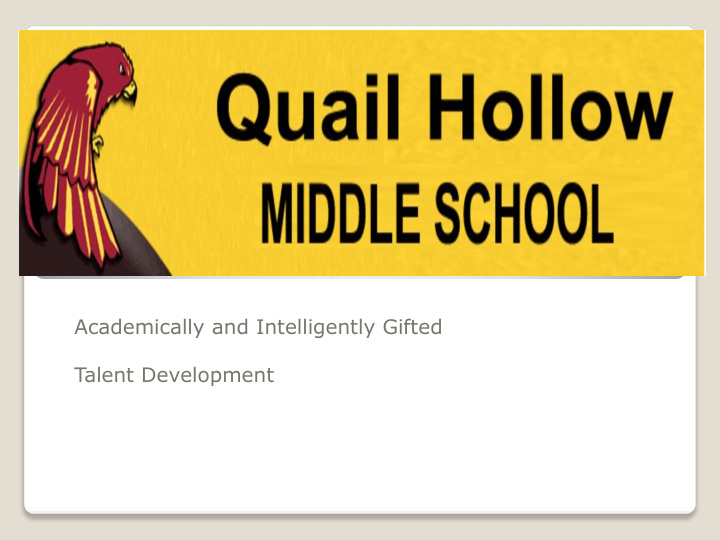



Academically and Intelligently Gifted Talent Development
~ Students are provided learning experiences and assessments that are conceptually advanced, challenging and complex. Lessons involve critical thinking, creative problem solving and inquiry- based assessments/projects. Teachers will use pre and post data to determine students’ strengths and weaknesses as well as ensure that students have mastered concepts taught. ~ Our Goal: to provide appropriately challenging, stimulating experiences throughout the school day. How is middle school TD different from elementary school TD? Talent Development Department
~ 6 th grade - All ELA courses implement Beers and Probst, Notice and Note Signposts to target and support Common Core State Standards. Within this program, individual student needs are targeted through changes in content, process, product, and learning environment. Students at this level will complete more independent writing tasks and at-home reading closely aligned to textual analysis. Reading material or the complex tasks themselves are differentiated for each student as reflected in various data points. Additionally, all students are immersed in comprehensive close reading analysis grounded in Academic Conversations and various writing to learn (informal) and learning to write (formal process writing) tasks. You can visit the CCSS website to review the 6 th grade specific standards. Language Arts Curriculum
~ 7 th Grade: All ELA courses implement Beers and Probst, Notice and Note Signposts to target and support Common Core State Standards. Within this program, individual student needs are targeted through changes in content, process, product, and learning environment. Additionally, all students at this level study vocabulary through study of Greek and Latin root words and grammar by engaging in the full writing and editing process several times throughout the year. Finally, in 7th grade, ELA standards are supported through several interdisciplinary units where ELA and SS classes combine to study an era of history through the close reading and analysis of texts. Language Arts Curriculum
~ 8th grade - All ELA courses implement Beers and Probst, Notice and Note Signposts to target and support Common Core State Standards. Within this program, individual student needs are targeted through changes in content, process, product, and learning environment. Students at this level will complete more independent writing tasks and at-home reading closely aligned to textual analysis. Reading material or the complex tasks themselves are differentiated for each student as reflected in various data points. Additionally, all students at this level are immersed in comprehensive vocabulary study grounded in Greek and Latin root words (as they apply to an overall understanding of the language). They are also immersed in comprehensive close reading analysis grounded in Academic Conversations and various writing to learn (informal) and at least 4 formal learning to write (formal process writing) tasks. Language Arts Curriculum
~ 6 th Grade: Instructional time should focus on four critical areas: (1) connecting ratio and rate to whole number multiplication and division and using concepts of ratio and rate to solve problems; (2) completing understanding of division of fractions and extending the notion of number to the system of rational numbers, which includes negative numbers; (3) writing, interpreting, and using expressions and equations; and (4) developing understanding of statistical thinking. Mathematics Curriculum
~ 7 th Grade: Instructional time should focus on four critical areas: (1) developing understanding of and applying proportional relationships; (2) developing understanding of operations with rational numbers and working with expressions and linear equations; (3) solving problems involving scale drawings and informal geometric constructions, and working with two- and three- dimensional shapes to solve problems involving area, surface area, and volume; and (4) drawing inferences about populations based on samples. Mathematics Curriculum
~ Math 1 – is an integrated High School level class that builds on the algebra foundations developed in Math 8. The class covers Algebra subjects of Expressions, Equations, Inequalities, Factoring, Polynomials, Quadratics and Functions. Mathematics Curriculum
~ Math 2 is an integrated High School level class that builds on the Algebra foundations developed in Math I and incorporates Geometry and Probability. The class covers Algebra subjects of Expressions, Equations, Inequalities, Polynomials, Quadratics and Functions. Geometry subjects include Transformations, Congruence of two dimensional figures, Similarity of Triangles, Trigonometry and modeling situations with Geometry. Mathematics Curriculum
~ Students receive a Differentiated Education Plan (DEP) kept on file listing instructional strategies and curricula designed to challenge and create critical thinking opportunities Examples include: Signposts, Problem-Based Learning, Protocols, Inquiry-Based Learning and Personalized Learning Accountability
~ Students are typically tested in 2 nd grade to determine AIG status ~ All learners at Quail Hollow will receive appropriately leveled rigorous text, tasks, and assigned outcomes despite their AIG status ~ As a one-to-one school and a personalized learning model school, Quail Hollow assesses student mastery of objectives and determines next moves for instructional design QHMS challenges all students at their level of readiness to learn.
Desired Outcomes Curriculum studied in greater depth through the rigor of lessons and differentiated activities. Curriculum enriched to include above-grade level material when appropriate. Advanced pace of learning. Increased focus on independent reading while improving writing skills to prepare them for high school level Talent Development Department
Special Programs at QHMS Spelling Bee Science Olympiad Duke Talent Identification Math Olympiad Program (TIP) National Junior Honor Yoga art Teens Society (NJHS) - 8 th Boy Scouts of America grade Girls on the Run Drama Club Cross County for Youth Future Problem Guitar Club Solvers Talent Development Department
For questions or concerns LaShae Tietsort, MultiClassrom Leader Lashaem.tietsort@cms.12.nc.us Renee Meyrose, MultiClassroom Leader Renee.meyrose@cms.k12.nc.us
Recommend
More recommend